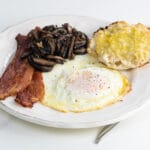Types of Fried Eggs
Here's how to make really great fried eggs, no matter how you like them. This recipe makes one egg, but if you want to make two, you don't need to double the butter or change anything else.
Servings: 1 egg
Calories: 173kcal
Ingredients
- 1 tablespoon (14 grams) good butter
- 1 large egg
- Fine sea salt and freshly ground black pepper optional
Instructions
- Place the butter into an 8-inch nonstick pan and set over medium heat.
- When butter is melted, crack the egg against your flat work surface and add it to the pan. (You can place it into a small bowl first if you feel more comfortable sizing it up before sliding it into the pan.)
For all types of fried eggs, leave the egg alone until it's set underneath and beginning to set on top. Then proceed according to type:
- For sunny-side up, reduce the heat to low and simply continue cooking until the white and yolk are set to your liking. Or, if you prefer crisp edges and a less-tender underside, you can leave the heat as-is or even raise it a bit so that the bottom cooks much faster than the top.
- For a Celia egg, place a cover over the pan, reduce the heat to low, and cook until the edges are slightly crispy and the yolk is jammy but not hard.
- For over-easy, flip the egg carefully, without breaking the yolk, and cook for just a minute or so more, until the underside sets but the yolk is still very runny.
- For over-medium, flip and continue cooking until the yolk gets a bit jammy. You can get an indication of the yolk's viscosity by shaking the pan a bit and seeing how much the center of the egg wobbles. Over time you'll learn how to achieve your ideal results with your particular tools.
- For over-hard, I like to prick the yolk with the tip of a knife or the tines of a fork before flipping, then flip and continue cooking until the yolk sets. Alternatively, you can flip without pricking and simply cook until the yolk cooks through. This latter method results in firmer whites as well.
- Slide the egg onto a serving plate and sprinkle with salt and pepper if you like. That's it!
Notes
- Please refer to the post above to learn more about sourcing eggs.
- Butter imparts delicious flavor and is easy to work with at the lower heat used for frying eggs. If you prefer, you can substitute bacon fat, which also adds lots of flavor and can help encourage crispy edges. Olive oil works nicely for a vegetarian and dairy-free option. If using olive oil, include a bit of salt.
- A sprinkle of truffle salt works beautifully if you're in the mood.
- Fried eggs want to be cooked just before serving. They're ready in under five minutes, so in the vast majority of circumstances, it shouldn't be a problem. That said, if you somehow end up with a leftover fried egg, you can keep it in an airtight container in the fridge for up to a week, reheat with a quick spin in a frying pan or on half power in the microwave, and add it to virtually any dish, from a burger to a bowl of spaghetti.
Nutrition
Serving: 1 | Calories: 173kcal | Protein: 6g | Fat: 16g | Saturated Fat: 9g | Polyunsaturated Fat: 6g | Cholesterol: 217mg | Sodium: 162mg
